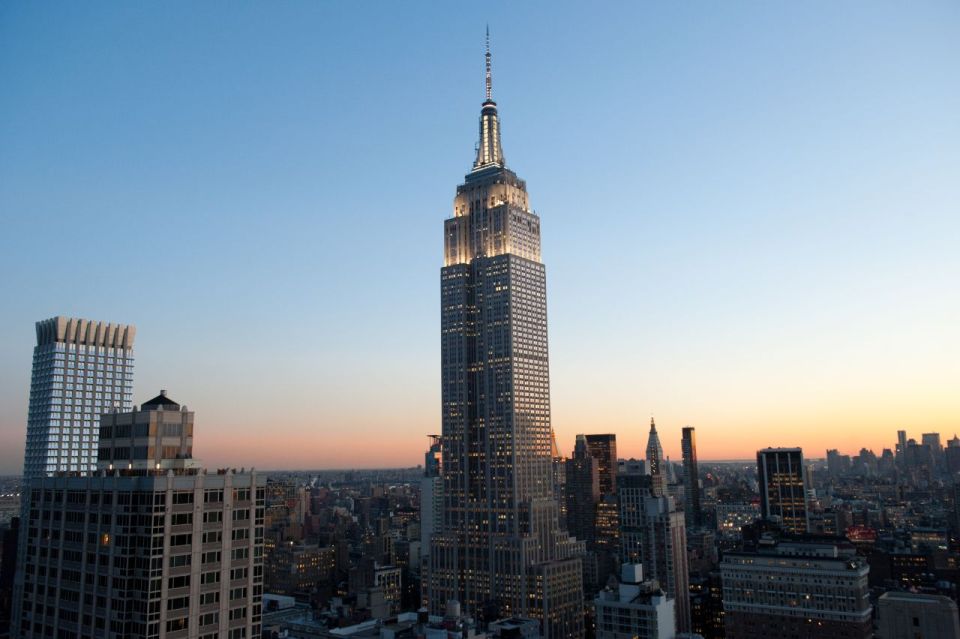About Empire State Building
Completed in 1931, the Empire State Building is a 102-story steel-framed skyscraper located at 34th Street and Fifth Avenue in Midtown Manhattan, New York City. Until 1971, the Empire State Building was considered the tallest building in the world. The Empire State Building is known for its distinctive and iconic Art Deco design and is considered one of the finest examples of modernist architecture in the United States.
The building was constructed during a time of intense competition to be the tallest in the world. The Chrysler Building claimed this title in 1929, and the Empire State Building took the title in 1931. Originally intended to be a terminal for airships, the building stands at a height of 381 meters (1,250 feet) with its iconic spire. In 1950, a 68-meter antenna was added, increasing the building’s total height to 449 meters (1,472 ft). However, in 1985, the antenna was replaced and the building’s height was reduced to 443 meters (1,454 ft). (At the time, One World Trade Center, which officially opened in 1972, became the tallest building in the world.
The Empire State Building was developed by John J. Raskob and Al Smith. Raskob, a successful businessman and former chairman of the finance committee at General Motors Corporation, and Smith, the former Democratic governor of New York, seemed like an unlikely pair. However, their lasting friendship may have been based on their shared experiences as children of Catholic immigrants struggling to make their way to the United States. Raskob and Smith were able to relate to each other’s struggles and successes.
Before working on the Empire State Building in 1929, Smith had recruited Raskob as chairman of the Democratic National Committee and as his campaign manager for his second bid for the US presidency in 1928. Despite Smith’s defeat of Republican candidate Herbert Hoover, the election showed that voters were not willing to risk the economic prosperity of the 1920s by electing a Democrat, nor did they want to choose a Catholic who could potentially challenge the Protestant values of the majority.
After losing the 1928 election and the governorship in his bid for the presidency, Smith was out of work. It is unclear whether the idea for building a skyscraper on the site of the original Waldorf Astoria Hotel originated with Raskob or Smith, but the two ultimately teamed up on this ambitious and attention-grabbing project. Raskob was a key investor and helped to recruit additional investors, while Smith, a well-known and respected figure, oversaw the project as president of the newly formed Empire State Building Corporation. On August 29, 1929, Smith announced plans for the record-breaking building, which was designed by Shreve, Lamb & Harmon Associates.
Construction began on March 17, 1930, but between the announcement in August and the start of construction in March, the stock market crashed in October 1929 and the Great Depression began. Despite these challenges, construction continued and employed many in New York City. The building was officially opened on May 1, 1931, and was completed in an impressive 410 days. Despite the media attention surrounding the Empire State Building, the Great Depression impacted its opening, and the building was nicknamed “The Empty State Building” due to the high number of vacant office spaces. It took about 20 years for the building to become profitable.
The Empire State Building has held world records, made appearances in various media, and remains a beloved icon of New York City. The observatories on the 86th and 102nd floors attract millions of visitors each year, and since 1994, an annual contest has offered couples the chance to win a Valentine’s Day wedding at the 86th-floor observatory. The building has been featured in several romantic films, including Love Affair (1939) and its remake An Affair to Remember (1957), as well as the hit rom-com Sleepless in Seattle (1993), which references An Affair to Remember. The Empire State Building has also made appearances in various movies, video games, and comics. In 2020, the building completed a multi-year renovation that significantly reduced energy use, decreased emissions by around 40%, and increased efficiency. This renovation demonstrated the building’s commitment to green engineering.



